|
Shoreline
Habitat Enhancement
JOHNíS
WALK LAKESHORE PROJECT
Go
To:
Implementation
Monitoring
Location:
Along
waterfront in Johnís Walk Subdivision, Nelson, British
Columbia
Client:
Subdivision
developer
Objective:
Establish
riparian vegetation to enhance fish habitat, reduce
sediment delivery and stabilize eroded bank sections
along the West Arm of Kootenay Lake.
The
Johnís Walk subdivision is located on the former Kootenay
Forest Products plywood mill site in the city of Nelson.
Based on the Federal Department of Fisheries and Oceans
requirement, in order to obtain approval for residential
sub-division, the developer had to provide enhancement
of shoreline fish and wildlife habitat. Terra Erosion
Control Limited was retained to develop and implement
a shoreline reclamation / habitat enhancement prescription
for this area.
The
shoreline treatment is approximately 580 m in length,
with banks ranging from 35 to 80% in slope gradient.
A pedestrian pathway runs along the top of the bank.
A small stream (Anderson Creek) also enters Kootenay
River along this section of shoreline; the banks along
the lower reach of this stream were also treated.
|
|
Johnís
Walk Shoreline before treatment,
February
2005
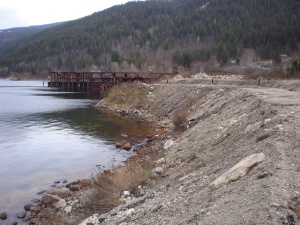
Peninsula
on Johnís Walk Shoreline before treatment, February
2005
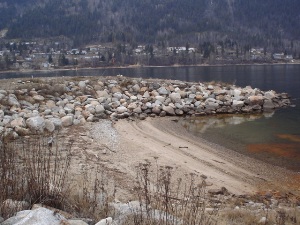
|
|
Johnís
Walk Shoreline before treatment,
February 2005
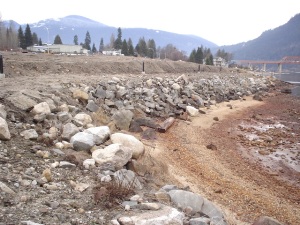
|
Johnís
Walk Shoreline before treatment,
February 2005
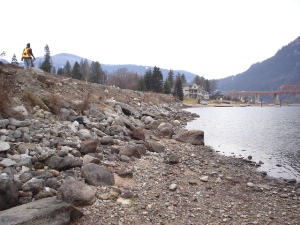
|
| |
Lower
reach of Anderson Creek before treatment, February
2005
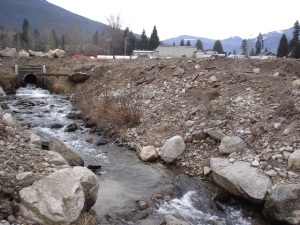
|
|
Implementation:
The
prescription developed for
this area was implemented in April 2005; it included
the use of brush layers and live cutting pockets
in riprap. Planting of structures was machine
assisted using an excavator. Straw wattles were
also installed in some areas to control surface
erosion. Prior to their installation, these wattles
were used as temporary sediment barriers during
construction. The area was also hydro-seeded with
a mixture of native grasses and legumes, and planted
with a native rose species (Rosa acicularis).
Live
cuttings used in soil bioengineering structures
were collected locally in spring 2005, and composed
of a mixture of Willow (Salix bebbiana / scouleriana
/ exigua) and Red Osier Dogwood (Cornus
stolonifera). |
| |
Machine-assisted
installation of brush layers,
April 2005
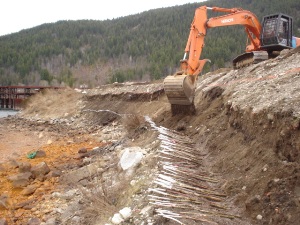
|
Machine-assisted
installation of brush layers,
April 2005
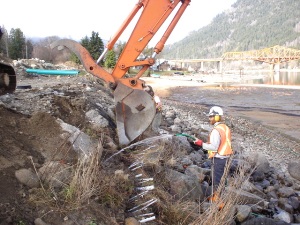
|
| |
|
Placing
live cutting pocket into riprap,
April 2005
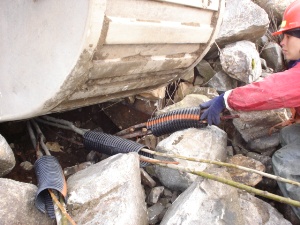
|
Live
cutting pockets in riprap,
April 2005
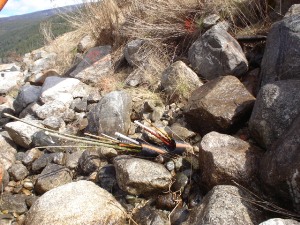
|
| |
|
Straw
wattle used as temporary sediment barrier during
construction, April 2005
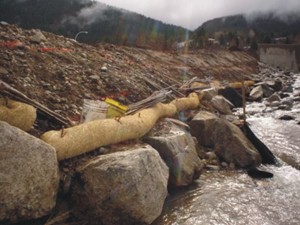
|
Straw
wattles installed between brush layers to control
surface erosion, April 2005
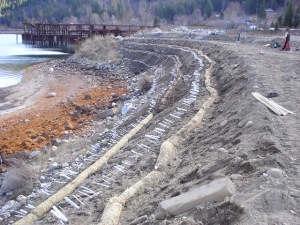
|
| |
|
Monitoring:
During
the summer of 2006 weed invasion, mainly Alfalfa
(Medicago sativa),
was a problem on this site necessitating manual
weeding treatments. The seed source for the seeds
is assumed to be within the imported construction
fill materials.
As
of spring 2007 the survival and growth of brush
layers, the bulk of the structures installed,
was assessed as fair to good. Although a portion
of the live cutting pockets placed in riprap were
growing well, they did poorly overall. Weed invasion
was still a problem, but becoming less so as the
Willow and Dogwood are emerging in height growth.
Overall the objective of establishing riparian
vegetation on this challenging site (due to heavy
weed competition) was accomplished.
The site was further monitored in 2010 and 2014. |
Growth,
June 2005
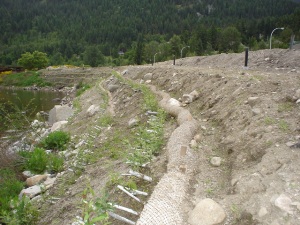
|
Growth,
June 2005
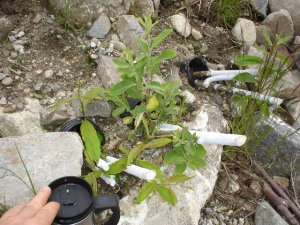
|
| |
Growth,
September 2005
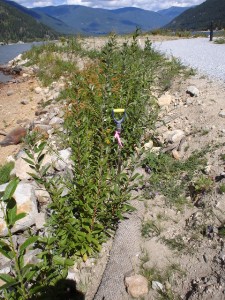
|
Growth
ďCornus
stoloniferaĒ, September 2005
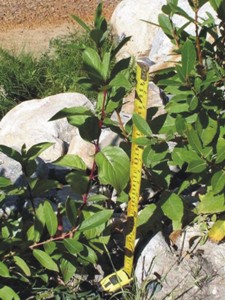
|
Growth,
September 2005
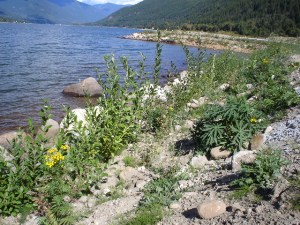
|
Growth,
September 2005
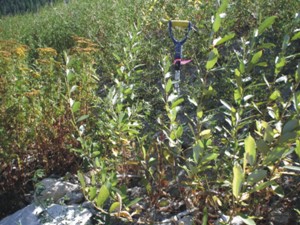
|
| |
|
Growth
of pockets in riprap, September 2005
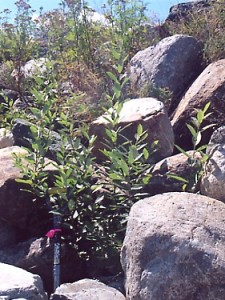
|
| |
Growth
after manual weeding treatment,
November 2005
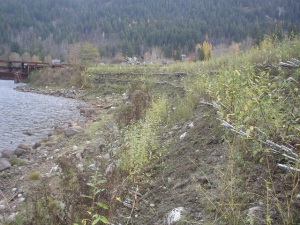
|
Growth,
August 2006
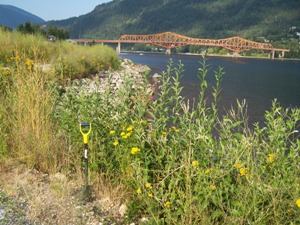
|
| |
|
Johns
Walk shoreline, spring 2007
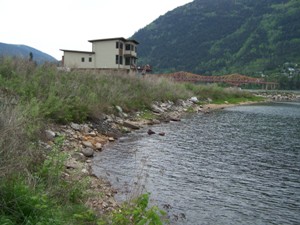
|
Growth,
spring 2007
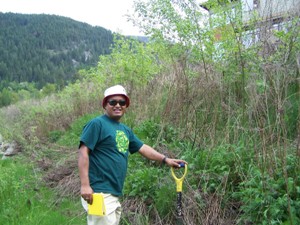
|
| |
|
Growth,
spring 2007
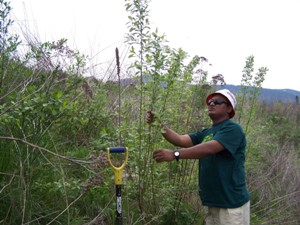
|
Anderson
Creek, spring 2007
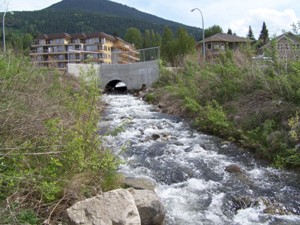
|
| |
|
Growth
next to Anderson Creek, spring 2007
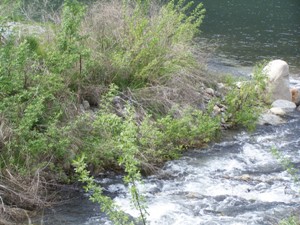
|
Shoreline,
spring 2007
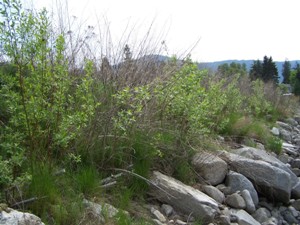
|
| |
|
Anderson Creek, summer 2010
|
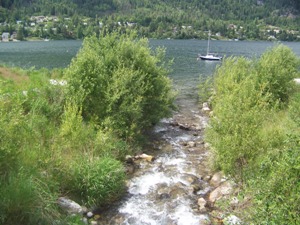
|
|
| |
|
Growth, summer 2010
|
|
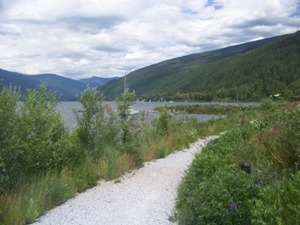
|
| |
|
Lower
reach of Anderson Creek before treatment, February
2005

|
Lower
reach of Anderson Creek after treatment,
summer 2010
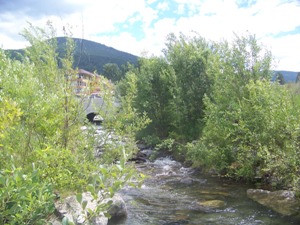
|
| |
|
Field tour, fall 2014 |
|
|
|
|
Field tour, fall 2014
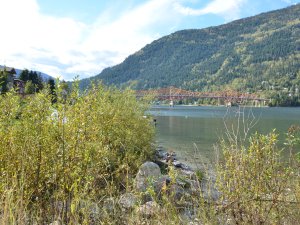
|

Copyright © 2010
Terra Erosion Control Ltd.
Shoreline Habitat Enhancement |
|
|
|

